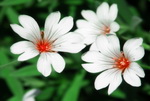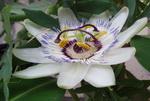|
  
There are already about 250,000 species of flowering plants that have been discovered and named. The basis for their diversity comes from their incredible reproductive success in a wide variety of habitats. The success of this group is also reflected by the diversity of their flowers that show astonishing displays of different forms, sizes, shapes, and colors all of these to lure pollinators and effect sexual reproduction.
Flowers are considered as an organ system because they are made up of two or more sets, or whorls, of leaflike structures. A typical flower is composed of four whorls, which are the sepals, petals, stamens, and apistil with one or more carpels. Much of the variation among flowers is based on variation of these basic parts.
Complete and Incomplete Flowers
A flower that has all four whorls of floral parts is said to be a complete flower (such as the hibiscus and the lily). An incomplete flower lacks any one or more of these parts (such as those of elms, willows, oaks, and plantains). With or without sepals and petals, a flower that has both stamen and pistil is called a perfect flower. Thus, all compete flowers are prefect, but not all perfect flowers are complete. In contrast, types of flowers that have only stamens or only pistils are called imperfect flowers.
Unisexual and Bisexual Flowers
Unisexual flowers are either staminate (bearing stamens only) or pistillate (bearing pistils only) and are said to be imperfect. Bisexual flowers are perfect because they have both stamens and pistil. When staminate and pistillate flowers occur on the same individual, the plant is called monoecious (examples include corn and the walnut tree). When staminate and pistillate types of flowers are borne on separate individual flowers, the plant is said to be dioecious (examples include asparagus and willow).
Superior or Inferior Ovaries
The position of the ovary also varies among different flower types. A flower has a superior ovary when the base of the ovary is located above where the sepals, petals, and stamens are attached. This point of attachment is referred to as the receptacle or hypanthium, the fused bases of the three floral parts (tulips and St. John's wort are examples). An inferior flower has an ovary below where the sepals, petals, and stamens are attached (as do daffodils and sabatia). Some flowers show an intermediate type, where the receptacle partly surrounds the ovary; the petals and stamens branch from the receptacle about halfway up the ovary (as in cherry, peach, and almond flowers).
Hypogynous, Epigynous, and Perigynous Flowers
The position of the ovary in relation to the attachment of floral parts also varies from superior to inferior ovaries. Flowers in which the sepals, petals, and stamens are attached below the ovary are called hypogynous, and the ovaries of such flowers are said to be superior (as in pelargonium and silene). Flowers in which the sepals, petals, and stamens appear to be attached to the upper part of the ovary due to the fusion of the hypanthium are called epigynous, and the ovaries of such flowers are said to be inferior (as in cornus and narcissus). Flowers types in which the hypanthium forms a cuplike or tubular structure that partly surrounds the ovary are called perigynous. In such flowers, the sepals, petals, and stamens are attached to the rim of the hypanthium, and the ovaries of such flowers are superior.
Fused and Distinct Floral Parts
The parts of a flower may be free orunited. Fusion of like parts (such as petals united to petals) is called connation. When like parts are not fused, they are said to be distinct(one petal is distinct from another petal). Fusion of unlike parts (stamens united to petals) is called adnation, and the contrasting condition is called free(stamens are free from petals). Fused structures may be united from the moment of origin onward, or they may initially be separate and grow together as one later in development.
Regular and Irregular Flowers
In many different flowers, the petals of similar shape radiate from the center of the flower and are equidistant from one another. Such types of flowers are said to have regularor radial symmetry. In these cases, even though there may be an uneven number of sepals and petals, any line drawn through the center of the flower will divide it into two similar halves. The halves are either exact duplicates or mirror images of each other. Flowers with radial symmetry are also called actinomorphic flowers(examples: stonecrop, morning glory). Flowers with irregularor bilateral symmetryhave parts arranged in such a way that only one line can divide the flower into equal halves that are more or less mirror images of each other. Flowers with bilateral symmetry are also called zygomorphic flowers(examples: mint, pea, snapdragon). A few flowers have no plane of symmetry and are referred to as asymmetrical.
Corolla Shapes
Corollais the collective term for all the petals of a single flower. This is usually the showy part of the flower.
Continue of the article: Corolla Shapes
Flowers of Monocots and Dicots
Floral variation provides part of the basis for dividing the flowering plants into two major groups: the dicotyledonsand the monocotyledons.
Continue of the article: Flowers of Monocots and Dicots
Types of Inflorescence
Flowers may be solitary, or they may be grouped together in an inflorescence, a cluster of flowers. An inflorescence has one main stalk, or peduncle.
Continue of the article: Types of Inflorescence
|
